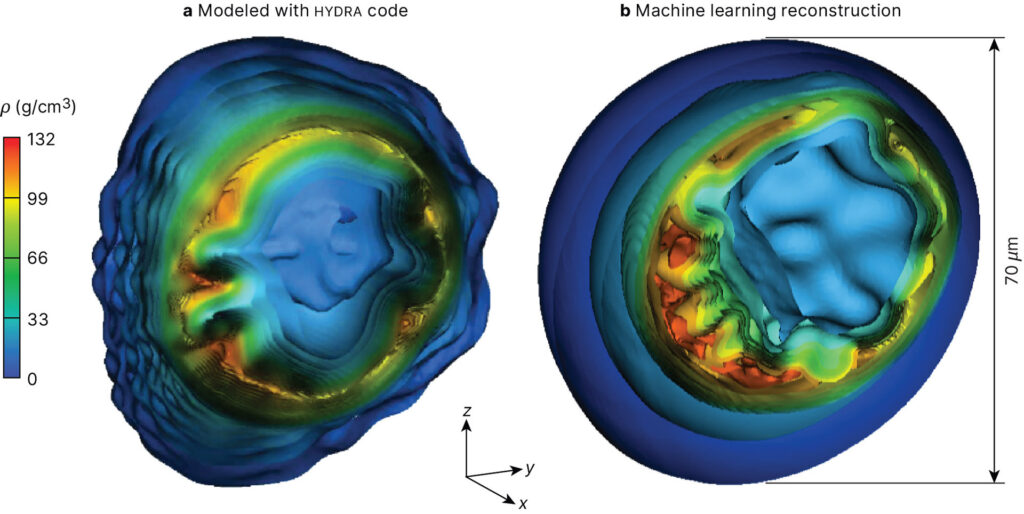Integrating Machine Learning Techniques for Enhanced Performance
Inertial confinement fusion (ICF) holds promise as a powerful energy source capable of producing bursts of energy measured in hundreds of megajoules. It has the potential to support both national security and the development of clean, sustainable energy. At Lawrence Livermore National Laboratory, scientists recently reached ignition using a laser-indirect-drive approach. Meanwhile, researchers here at LLE’s Omega Laser Facility are taking a different path studying laser direct drive, a method that could prove to be more energy efficient. Unlike laser indirect drive, which works by converting laser beams into x rays that heat and compress the target, laser direct drive applies the laser energy directly to the target itself. This direct interaction can achieve higher compression with less energy input, but it also makes it harder to keep the implosion symmetric—a key factor in triggering fusion.

This article explores how imperfections in the drive symmetry of laser direct drive implosions can lead to uneven compression of the fuel capsule, leaving behind residual kinetic energy. This leftover energy, which fails to contribute to compressing the fuel, ultimately limits the total energy output of the implosion [1]. LLE scientists Jack Woo and Kristen Churnetski, a doctoral student in mechanical engineering, are investigating deep-learning neural network models to create 3D reconstructions of the hot spots formed during implosions. Their work helps scientists better understand and correct the asymmetries that can limit the efficiency of fusion experiments on the OMEGA Laser System.
On the OMEGA Laser System, 60 high-power ultraviolet laser beams deliver up to 30 kJ of energy onto spherical targets. The goal is to drive a smooth, symmetric compression of a fusion capsule with layered fuel. As the laser strikes the outer surface of the target, the material ablates and the ablation blows material off (outward) creating the “rocket effect” that accelerates (or pushes) the remaining material inward. This forms a high-temperature, low-density central hot spot surrounded by a dense, colder shell of fuel. For ignition to occur, the pressure in the hot spot must soar to nearly 100 Gbar—approximately 100 billion times the atmosphere of Earth—and remain at this pressure for roughly 70 trillionths of a second. However, imperfections in the implosion often stand in the way, disrupting the symmetry needed to reach those extreme conditions [2,3,4].
There are several sources of asymmetry in laser-direct-drive implosions. First, the target is illuminated by only a finite number of laser beams. Each beam has a slightly different focal profile and pulse shape, and no beam is perfectly aimed at the exact center of the target. Combined, these factors produce nonuniformities known as low-mode asymmetries. Scientists describe these nonuniformities using spherical harmonics and focus on the lowest few modes, which tend to have the greatest impact on performance. Low-mode asymmetries reduce the effectiveness of the implosion by limiting how much the fuel can be compressed.
To picture the challenge, imagine squeezing a balloon. When pressure is applied evenly and from all sides, the balloon’s shape will remain uniform and intact, with no bulges or distortions. But with two hands, a person can only squeeze from opposite directions, causing air to bulge out from the sides. Something similar happens when low-mode asymmetries distort the compression of a fusion target. The material in regions with stronger drive pushes into areas where the laser energy is weaker, breaking the symmetry and causing degradation in fuel compression.
In an ideal implosion, the compression is perfectly spherical, and all motion within the fuel stops at the moment of peak compression. This means that the kinetic energy used to compress the fuel is fully converted into internal energy in the hot spot and surrounding fuel. When the implosion is asymmetric, however, the fuel continues moving, even at peak compression. This leftover motion drains energy from the system, a phenomenon known as residual kinetic energy. The greater the asymmetry, the more energy remains in motion rather than contribute to the pressure and temperature needed for fusion. As a result, the fusion yield drops, limiting the overall performance of the implosion [5,6].
Scientists can detect this lingering motion by analyzing the energy spectrum of the neutrons produced during fusion reactions between deuterium and tritium. In a perfectly symmetric implosion, the neutron spectrum forms a bell-shaped curve, and its width reflects the ion temperature of the fuel. In an asymmetric implosion, however, different parts of the shell move at different speeds, and the extra motion adds to the width of the spectrum. By measuring the neutron spectrum along different directions, researchers can infer the extent of residual fuel motion. Because both thermal motion and flow contribute to the broadening of the spectrum, the result is an “apparent” temperature that varies depending on where it is measured. The greater the difference between directions, the more residual motion is present in the fuel [7].
In addition to measuring apparent temperature differences, researchers also examine the shape of the x rays emitted by the hot plasma in the core. Variations in the x-ray image offer another clue to understanding how low-mode asymmetries shape the implosion from within [8,9,10].





